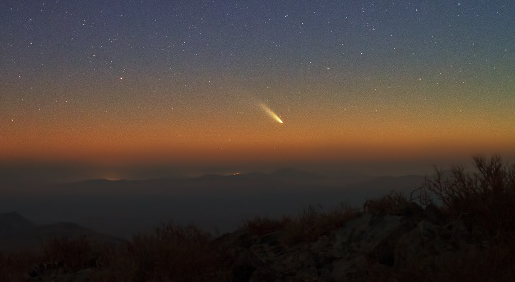March 6, 2013 10:31 pm
Meteors, Asteroids… What’s Next, a Comet?

Comet C/2011 L4 PanSTARRS, photographed over the Atacama Desert in South America. Photo Courtesy of apod.nasa.gov. Image Credit & Copyright: Yuri Beletsky (ESO)
Two, in fact. The comet PANSTARRS, tomorrow, and ISON, later this year.
PANSTARRS came the closest it’s going to come to Earth yesterday, March 5th, but starting tomorrow, it should be visible in the Northern Hemisphere. And while predicting the quality of comets is a tricky thing (anybody remember the fizzle that was Kohoutek?), there have already been some great images of PANSTARRS taken from the Southern Hemisphere, where it’s been visible since February.
PANSTARRS is also written as Pan-STARRS, which can be confusing but explains the name. That’s because comet C/2011 L4 PanSTARRS, which originated in the Oort Cloud, was discovered in June 2011 by the Panoramic Survey Telescope & Rapid Response System (Pan-STARRS) atop the Haleakala volcano in Hawaii.
According to NASA, predicting exactly what PANSTARRS’s journey will look like is made more complex because this is the first time PANSTARRS has visited our solar system. Speaking of predicting comets, EarthSky.org has a great quote from comet-hunter David Levy: “Comets are like cats; they have tails, and they do precisely what they want.”
How To See PANSTARRS
To see it, face west just after sunset. Aim a bit left from where the sun goes down. Try and get an unobstructed view, away from lights. You can see PANSTARRS with the naked eye, but it should be even more spectacular through binoculars.
When to See PANSTARRS
While it’s first visible on the 6th, the best viewing could be on the 10th, when PANSTARRS comes closest to the Sun, when the icy comet and the heat from the Sun should combine to give us quite a show.
Two of the more interesting nights to see PANSTARRS should be on March 12th and 13th just after sunset. There will be a young moon on those nights, so even though that will add more distracting light into that part of the sky, the sight of the young crescent moon and the passing comet together should be memorable.
After PANSTARRS, we only have to wait about 8 months for what some are calling “The Comet of the Century”: ISON. ISON might even be visible in daylight to the naked eye. We’ll have more on that as we get closer to November, when ISON comes closest to Earth.
More Information about PANSTARRS
Here are a few great websites to find out more about PANSTARRS:
NASA has a video about PANSTARRS and the Oort Cloud here.
Earthsky.org has a month-by-month viewing guide here.
Sky and Telescope has a continually updated coverage of the comet starting back in January.
And of course Universe Today has its typically informative, educational and enjoyable PANSTARR viewing information here.
That’s it for now. Keep Looking Up!
–Jeffrey Simons
Get the most out of StarTalk!
Ad-Free Audio Downloads
Ad-Free Video Episodes
Stickers & Mugs
Live Streams with Neil
Priority Cosmic Queries
Early-Access Videos
Learn the Meaning of Life
...and much more

 Become a Patron
Become a Patron

